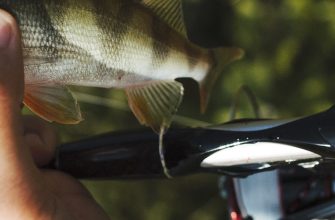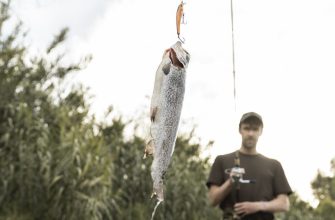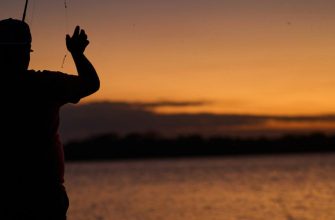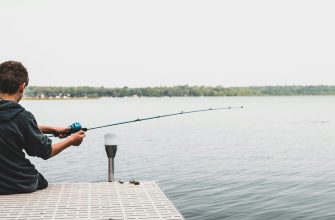- Introduction to the Little Red River in Arkansas
- Little Red River Trout Species
- Seasonal Guide to Trout Catching
- Best Times of Year for Trout Catching
- Weather Conditions and Trout Behavior
- The Art of Fly Fishing on the Little Red River
- Fly Fishing Equipment for Trout
- Rods and Reels
- Flies
- Waders and Boots
- Other Essentials
- Best Trout Fishing Spots
- Fly Fishing Techniques for Trout
- Best Fly Fishing Practices
- Jigging Roadrunner Jigheads with Soft Plastics
- Slow-twitching Countdown Rapalas
- Seasonal Hatches and Trout Flies
- Seasonal Flies Hatches
- More Recommended Flies
- Little Red River Local Regulations
- Planning Your Trip
- Places to Stay Nearby
- Public Access Areas
- FAQs
- Q: What is the Little Red River known for?
- Q: What are the different types of fishing techniques that can be used on the Little Red River?
- Q: Are the trout in the Little Red River naturally reproduced?
- Q: When is the best time to fish the Little Red River?
- Q: What are some popular fishing spots on the Little Red River?
- Q: What are some of the most effective flies and baits for fishing on the Little Red River?
- Q: Can you fish from a boat on the Little Red River?
- Q: Is it possible to hire a fishing guide for the Little Red River?
- Q: Is the Little Red River home to any notable record catches?
- Q: Are there any regulations or restrictions for fishing the Little Red River?
Welcome to the Little Red River, Arkansas – a fly angler’s paradise. Boasting an abundant stock of cutthroat and brown trout that reproduce naturally, this waterway offers an experience unlike any other.
The Little Red flows with a rhythm and grace that captivates those who venture upon its high water. As you rig up your 4- or 5-weight rod, don’t be surprised if the anticipation makes your heart race.
During low flow, release schedule permitting, wading anglers can enjoy a more intimate connection with the river. However, boat anglers are not left out; drifting along in a boat allows you to cover a larger area.

This river is famed for its macroinvertebrates, which serve as a rich food source for the trout. As a result, nymphing is often the most effective technique to catch more fish.
The Little Red is known for its midge hatches, especially between January and February. March and April bring an emergence of small mayflies, and caddisflies flock to the waters in September and October. To increase your chances of success, consider using flies that mimic these insects, such as pheasant tails, zebra midges, red brassies, or copper johns.
Even on snowy days, the river keeps flowing, and the trout keep biting. The angling pressure is less intense during these times, making the trout easier to catch. But don’t let the water’s murky appearance fool you; beneath the surface, it teems with life.
As you cast your line into the water, be prepared for what may come. The river is home to sculpins and the occasional brook trout. These, along with the resident trout, make the Little Red Waterway a noteworthy fly fishing destination.
So, whether you’re a seasoned angler or new to fly fishing, the Little Red River in Arkansas awaits. Come explore its waters, experience the thrill of the catch, and create memories that will last a lifetime. This, dear reader, is the beauty of fly fishing the Little Red.
Introduction to the Little Red River in Arkansas
The Little Red River is considered one of the top trophy trout fisheries in the Southern United States. The river flows through North Central Arkansas.
The rive forms below Greers Ferry Dam and Greers Ferry Lake are impounded on the White River. The Little Red then flows over 20 miles through the limestone Ozark Mountains, replenished by numerous underground springs. The river then meanders west past the small towns of Heber Springs, Lobo and Shirley until merging with the Red River, a tributary of the Mississippi River.
With year-round cold water along with immense trout productivity and growth rates, the Little Red Waterway stands out as a world-class Southern trout destination for anglers far and wide.
Little Red River Trout Species

The Little Red Waterway is home to the following major trout species:
- Rainbow Trout are the most common and abundant species in this river. Rainbow trout up to 30 inches long and weighing up to 12 pounds are found.
- Brown Trout – live in the rive a constantly breeding population. Brown trout reach up to 25 inches in length.
- Cutthroat Trout are not as common in the Little Red waterway as the Brown and Rainbow Trout, but they can still be found.
- Brook Trout – lives upstream of Little Red and its tributaries. Brook trout are not as large, up to 15 inches maximum.
- Lake Trout are also occasionally found, but they do not naturally reproduce here, only imported.
Overall, Little Red is known for its large rainbow and brown river trout, reaching trophy sizes.
Seasonal Guide to Trout Catching
Best Times of Year for Trout Catching
The success of your fishing trip relies heavily on the timing of your visit.
Generally, the most fruitful periods for catching trout in the Little Red waterway are the spring and fall months. The slightly cooler temperatures during these seasons provide a comfortable environment for trout, making them more active and thereby easier to catch.
Spring is particularly lucrative for brook and rainbow trout fishing, as this is their spawning season. Meanwhile, fall is the ideal time for catching brown trout, which tend to spawn later in the year. Remember: the exact timing of these seasons can vary from year to year, so it’s always best to check ahead.
Weather Conditions and Trout Behavior
In addition to the time of year, weather conditions can also significantly impact your fishing experience. Trout, particularly rainbow trout, prefer cooler water temperatures, which typically fall between 50 and 60 degrees Fahrenheit. Therefore, overcast days can often yield a more successful catch than clear, sunny ones.
Rain also plays a crucial role in trout fishing. After rainfall, the river water becomes oxygenated, which attracts trout and makes them more active. However, heavy rain can make the river too turbulent for a successful catch.
Understanding the behavior of trout in relation to weather conditions is key to planning a successful fishing trip. As such, always keep an eye on the forecast before heading out to the Little Red River.
The Art of Fly Fishing on the Little Red River
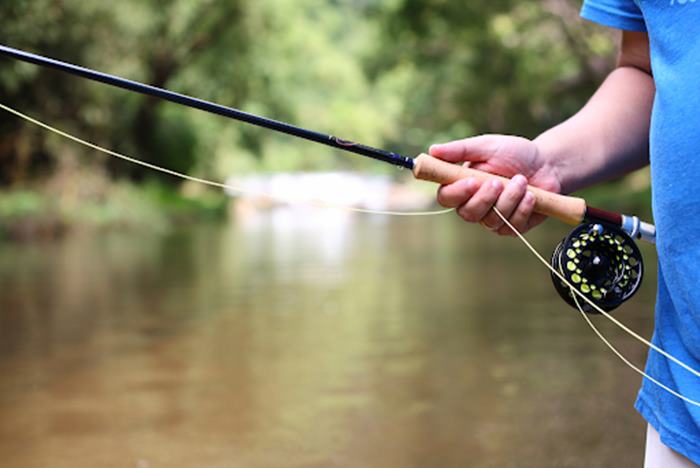
Fly Fishing Equipment for Trout
Rods and Reels
A good fly rod and reel are the foundation of any successful fly fishing expedition. For the best experience, consider a 4-weight to 6-weight rod, which offers the perfect balance of power and precision for casting flies. The reel should have a smooth drag system to handle the fight of a trout on the line.
Read more: Best Trout Fly Fishing Streams on the Tellico River in Tennessee
Flies
Choosing the right fly is crucial when fishing for trout. The hatch in the region often includes insects like caddis and mayflies, so having imitations of these in your fly box is a smart move. Don’t forget to also pack some nymphs and streamers for when the trout are not rising to the surface.
Waders and Boots
A quality pair of waders and boots are necessary for wading into the river. Look for breathable waders for comfort and rubber-soled boots for stability on slippery river bottoms.
Other Essentials
Don’t forget your fishing license, as it’s required for all anglers. Also, consider packing a fishing vest to keep your gear organized and easily accessible. Items such as polarized sunglasses and a wide-brimmed hat are also recommended for protection against the sun.
Best Trout Fishing Spots
Key areas along the renowned fly fishing and spin fishing river include State Park, Tate’s Bluff, John F. Kennedy Park, Gray’s Landing, Allison’s Landing and Brownsville access points.
While wading access and float trips are both popular, limitations exist in the Special Regulation sections near the dam which are restricted to prevent overfishing of the trout-rich environment.
The best fishing areas are the pools, drops, and snags in the middle river drifts. Focus efforts on outside river bends and creek mouths where turbulent flows congregate trout. In addition, submerged boulders, stumps, and timber create current seams for lurking lunkers.
Fly Fishing Techniques for Trout
Slow twitching, long casts of small crankbaits drifting downstream, and vertical jigging prove effective in the Little Red. Fluorocarbon leaders increase strikes.
Best Fly Fishing Practices
I use two primary methods for effectively catching trout in Little Red waterway – jigging Roadrunner Jigheads with Soft Plastics and slow-twitching Countdown Rapalas.
Jigging Roadrunner Jigheads with Soft Plastics
Jigging 1/8 ounce Roadrunners paired with 3-4 inch Plastic Worms or Twister Tails allows quick scanning of prospective lies throughout the water column and triggering strikes from lunker trout. The best areas are sections with moderate flow, up to 5-foot depth, and complex bottom structures containing snags, flooded timber, and boulders. A 10-foot fast action spinning rod with a 10 lb line provides the needed sensitivity and backbone for landing trophies.
Slow-twitching Countdown Rapalas
In calmer backwaters, I prefer slowly twitching suspending Rapala Originals at 1-1.5 meter depth along the shoreline contour. It’s a reliable way to provoke savage attacks from predators waiting in ambush below. 5/16 to 1/2 oz natural-colored Rapalas usually catch the eye of Brown and Rainbow brutes in the Little Red. I highly recommend giving it a shot!
Whether jigging or cranking, I always use fluorocarbon leaders to maximize strikes. And be sure to follow regs on keeping your limit of quality trout – the exceptional fishing Little Red offers is a fishery to conserve for future generations. I’m happy to elaborate further on my cherished methods for tackling this legendary trout venue.
Seasonal Hatches and Trout Flies

Seasonal Flies Hatches
When targeting trout on Arkansas’ famed Little Red waterbody, matching seasonal hatches with appropriate fly patterns can lead to success. Here are some key flies and strategies to employ during productive times of year in this tailwater fishery:
- March-April: The early spring months kick off intense Blue Wing Olive and Caddis activity. Drifting #16-18 BWOs and Caddis Larva/Pupa imitations along undercut banks and weed beds cues savage strikes.
- May-June: Prolific Pale Morning Dun mayfly hatches occur in late spring. Drifting low-floating #14-16 Sprout PMDs and Parachute Adams does the trick during the morning hours.
- July-September: Terrestrial fishing heats up in the summer months. Casting size 12-14 foam beetle, ant, and grasshopper flies to bankside structure and vegetation hooks Streamside trout.
- October-November: Leaden winter caddis activity intensifies in the fall. Dead drift a #14-16 CDC Caddis Emerger or DSD Caddis Pupa into back eddies and pools to entice more selective trout.
Be prepared to switch patterns until you discover what’s working. And use 4-6x tippets to land strong, wily trout with delicate presentations. Matching the hatch with flies tailored to Little Red’s unique hatches remains a reliable path to success.
More Recommended Flies
Here are some recommended flies that are known to attract trout in the Little Red River:
- Brown Sculpin and White Belly Sculpin and Articulated streamers (size 6/4): These streamers imitate the natural sculpin found in the river, making them irresistible to the fish.
- Black Matuka and Olive Matuka Sculpin (size 4/6): Similar to the previous flies, the Matuka Sculpin is another great choice that effectively mirrors the real-life sculpin in the river.
- Blue-winged Olives (size 16, 18 nymph, emergers, duns, and spinners): This fly is a staple in any angler’s box due to its versatility and efficacy in drawing trout’s attention.
- Aquatic Worms (size 12, pink, red, and others): These imitations of aquatic worms are especially effective after rainfall when natural worms are often washed into the river.
- Midges (Cream and Red (Blood) midges sizes 20/22, larva, pupa, and adult): Despite their small size, midges are a major part of a trout’s diet. Therefore, they are a must-have for any fly fisher.
- Winter Stoneflies (16/18): Stoneflies are another important fly to have in your box, particularly during the winter months when they are most active.
Remember, the key to successful fly fishing is not only using the right fly but also presenting it in the most natural way possible.
Little Red River Local Regulations

First and foremost, a valid Arkansas fishing license is required for all anglers aged 16 and over. Licenses can be purchased online, by phone, or at any license dealer. Please remember that an additional trout permit is necessary for trout fishing.
The river itself is divided into sections with different regulations. The most strictly regulated is the 2.5-mile catch-and-release area below Greers Ferry Dam. In this area, only artificial lures with barbless hooks are permitted, and all trout must be immediately released.
Read more: Trout Fishing on Soque River: Guide to Monster Trout Fly Fishing in North Georgia
Outside of the catch-and-release area, the daily limit is five trout per person, with only one of those exceeding 14 inches. Trout under 16 inches must be released in the Cow Shoals and Jon’s Pocket areas. It’s important to note that snagging is not allowed and fish hooked anywhere but inside the mouth must be released.
Night fishing is allowed, but using artificial light to attract fish in Greers Ferry Lake and Little Red River is prohibited. Additionally, all boats must comply with the Arkansas Boating Laws and Responsibilities rules.
Fishing hours, bag limits, and legal fishing methods can also vary depending on the season and species, so it’s recommended to check the current regulations on the Arkansas Game and Fish Commission website before your visit.
These regulations are in place to help maintain a healthy and sustainable fish population in Little Red River.
Planning Your Trip
Places to Stay Nearby
- John F. Kennedy Park Campground: As mentioned earlier, the park campground is a great choice for those wanting to stay close to the action. The campground offers all the amenities needed for a comfortable stay.
- Private Resorts: For those looking for a bit more luxury, there are private resorts available on both sides of the river. These resorts often offer guided fishing tours and other amenities.
- Hotels and Motels in the Local Town: For those who prefer more traditional accommodations, there are several hotels and motels in the local town. These offer the advantage of being close to other amenities, like restaurants and shops.
Public Access Areas
One of the great advantages of this destination is the variety of public access points available for enthusiasts. These areas are well-maintained and provide easy access to the stream.
- John F. Kennedy Park Campground: This campground is not only a great place to set up your base camp, but it also offers quick access to the stream. It’s an excellent choice for those who want to stay close to their fishing spot.
- Cow Shoals Access: Cow Shoals provide another excellent entry point to the stream. It’s known for its beautiful natural surroundings and the quality of the fishing available.
- Barnett Access: Barnett is a popular choice among enthusiasts. It offers a serene setting for a day of fishing – just you, the water, and hopefully a lot of fish!
- Libby Shoals Access: Libby Shoals is a favorite among locals. The fishing here is known to be consistent, and the area itself is stunningly beautiful.
- Lobo Access: Lobo is another excellent choice for the fishing trip. It is particularly popular among seasoned fishing enthusiasts due to the quality of the fishing available.
- Dripping Springs Access: Dripping Springs is a hidden gem. This access point is a bit off the beaten path, but it offers some of the best fishing in the area.
- Ramsey Access: Last but not least, Ramsey Access offers yet another great entry point to the stream. It’s a bit quieter than some of the other access points, which can be a big plus for those looking for a peaceful fishing experience.
Remember, planning is key to a successful fishing trip. Take the time to explore all the options and make the best choice for your needs. Happy fishing!
FAQs
Q: What is the Little Red River known for?
A: The Little Red River is known for offering an excellent experience in fly fishing for trout, particularly cutthroat and brown trout.
Q: What are the different types of fishing techniques that can be used on the Little Red River?
A: Anglers can enjoy streamer fishing, dry-fly fishing, and fishing with dry flies on the Little Red River.
Q: Are the trout in the Little Red River naturally reproduced?
A: Yes, the trout in the Little Red River reproduce naturally, making it an ideal habitat for these species.
Q: When is the best time to fish the Little Red River?
A: The Little Red River is a year-round fishing destination, but the water levels and conditions are often best for fishing from a boat during the spring and fall.
Q: What are some popular fishing spots on the Little Red River?
A: Winkley Shoals, the Collins Creek area, and the stretch from the dam to Ramsey access are popular spots for angling the Little Red River.
Q: What are some of the most effective flies and baits for fishing on the Little Red River?
A: Sow bugs, minnow imitations, and macroinvertebrates are commonly used to attract the large brown trout in the deep pools of the Little Red River.
Q: Can you fish from a boat on the Little Red River?
A: Yes, fishing from a boat is a popular option for anglers looking to explore and fish different sections of the river.
Q: Is it possible to hire a fishing guide for the Little Red River?
A: Yes, there are fishing guides available to provide assistance and enhance the experience for those seeking to catch the Little Red River.
Q: Is the Little Red River home to any notable record catches?
A: Yes, the Little Red River is known for harboring world-record brown trout catches, making it a sought-after destination for anglers.
Q: Are there any regulations or restrictions for fishing the Little Red River?
A: It’s important to familiarize yourself with the regulations and restrictions in place for angling the Little Red River, especially in areas where trout spawn successfully and where specific fishing equipment may be restricted.

